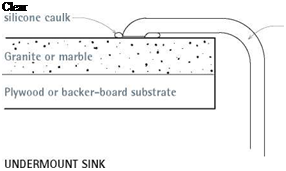Setting a Pedestal Sink
Installing a pedestal sink takes planning, a lot of adjusting, and two people. For starters, determine well in advance the height of the 2x blocking needed to anchor the sink, so you can cut that board into stud walls well before the drywall goes up.
Preattach the sink’s hardware before mounting it on the pedestal. Next, level the pedestal base, shimming it as needed. Ribbed plastic shims (also called ribbed stability wedges) work well for this task because their ribs keep them from slipping, even if it’s necessary to stack wedges on a badly out-of-level floor. Once the base is level, set the sink atop it and check it for level in two directions—front to back and side to side—using two torpedo levels, as shown in the left photo on p. 295. Chances are, you’ll need to reset the sink several times to get it level and stable because sinks and pedestals are often not perfectly mated.
Once you’re pleased with the sink’s placement, put a pencil in the back of the sink and mark the locations of the lag-screw holes onto the wall. Remove the sink, predrill the holes, start the lag screws, replace the sink, and check for level again. When the sink is level and the lag screws line up to the pilot holes, lift the sink slightly so a helper can slide out the pedestal, attach the drainpipes, slide back the pedestal and reset the sink, and finish tightening the washered lag screws. But don’t overtighten or you’ll crack the porcelain. Attach the supply risers top and bottom, test for leaks, and you’re done.


![]()


![]()
![]()



![]()
those shown above. Wall-mounted models slip down into a bracket, which must be lag screwed to blocking attached to studs—preferably let into the stud edges. Level the sink front to back and side to side.
Connect the drain. With the sink or lav in place, connect the drainpipe. To the drain stub sticking out of the walls, glue a threaded male trap adapter, which will receive a slip coupling. Slide the trap arm into the coupling, but don’t tighten it yet. The other end of the trap arm turns down 90° and, being threaded, couples to an adjustable P-trap, which you can swivel so that it aligns to the tailpiece coming down from the lav. The other end of the P-trap has another slip coupling, into which the sink tailpiece fits. When trap
pieces are correctly aligned, tighten the slip couplings.
Kitchen sinks are much the same, except that the upper part of a sink tailpiece is threaded to tighten to the bottom of a strainer body. To drain double sinks, use the hookups shown in "End – Outlet Continuous Waste,” on the facing page. Back-to-back lavs or sinks can also share a common drain, by using a figure-5 fitting (see the bottom photo on p. 277).
Connect supply pipes. To each supply pipe stub-out, attach a shutoff valve, typically an angle stop with a compression fitting. Slide the angle stop’s h-in. socket over the stub-out, and tighten the fitting so that the ferrule inside compresses and forms a positive seal. Alternatively, you can sweat /2-in. male threaded adapters onto the stub – outs, wrap Teflon tape on the threads, and screw on a shutoff valve with a h-in. threaded female opening.
Riser attachments depend on whether you install rigid chromed tubing, which inserts into a compression fitting on the angle stop, or a flexible braided supply line, which has nuts on both ends. Rigid tubing must be shaped with a tubing bender and cut to exact length, whereas braided supply can be easily twisted or looped so it fits.






Leave a reply